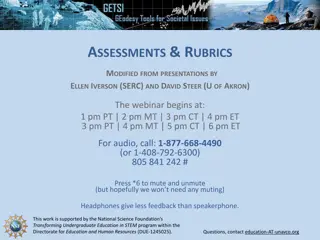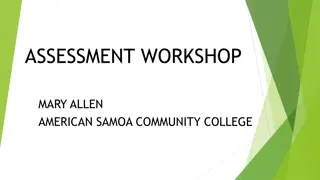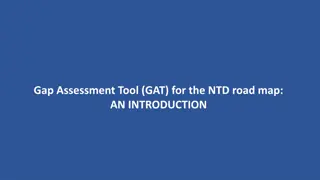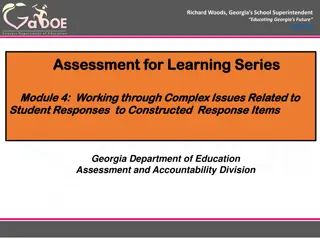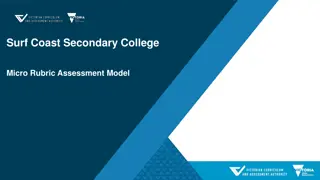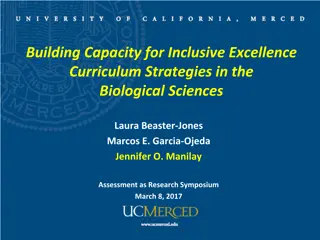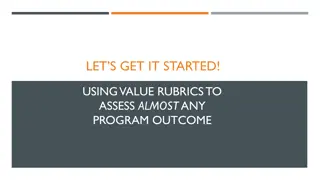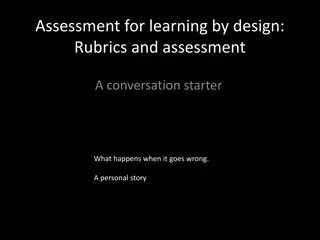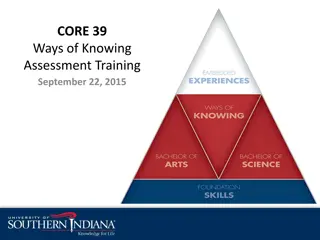Effective Rubrics in Assessment
A rubric is a detailed assessment tool that outlines criteria for evaluating work, such as purpose, organization, details, voice, and mechanics. It provides gradations of quality from excellent to poor for each criterion, aiding in fair and consistent grading. By using rubrics, teachers can offer personalized feedback efficiently, enhance task comprehension, facilitate self and peer assessment, and improve overall learning outcomes.
Download Presentation

Please find below an Image/Link to download the presentation.
The content on the website is provided AS IS for your information and personal use only. It may not be sold, licensed, or shared on other websites without obtaining consent from the author.If you encounter any issues during the download, it is possible that the publisher has removed the file from their server.
You are allowed to download the files provided on this website for personal or commercial use, subject to the condition that they are used lawfully. All files are the property of their respective owners.
The content on the website is provided AS IS for your information and personal use only. It may not be sold, licensed, or shared on other websites without obtaining consent from the author.
E N D
Presentation Transcript
Unit 5: Understanding Multiple- Choice Questions Written by Kathleen McCullough-Zander, MA, RN, CTN
Levels of knowledge Knowledge remember information (memorization) Comprehension understanding the meaning of information Application use information in a particular situation Analysis finding the commonalities, differences and connections in information, data and concepts
Test questions in nursing Usually at the level of application or analysis Need to apply more than one fact or concept to a situation There may be more than one right answer: need to select the best answer
Parts of a multiple-choice question What is the primary purpose of leg exercises after abdominal surgery? 1. Promote venous return 2. Prevent muscle atrophy 3. Increase muscle strength 4. Limit disabling contractures Stem Correct answer Distractor Distractor Distractor
Alternative format questions Matching Multiple answers select all that apply Fill in the blank Ranking Mark a part on a picture
Strategy for multiple-choice questions Identify the key concepts in the stem underline them Identify who is the central person in the question Put the question into your own words Think of the answer in your mind! Read all four answers Immediately cross out the answers you know are wrong You are usually left with two answers to choice from Which one is closest to the answer you had in mind?
Tips for success Do not add additional information into the stem or answers Be sure to notice specific words such as always, never, all, none Use time wisely skip a difficult question and come back later Cover the answers while you analyze the stem Wear earplugs if distracted by noise Be sure to fill in the correct circle on scanform 55.3% of the time students gain a point when changing an answer (Jordan & Johnson, 1990)
Test analysis Test analysis helps you to improve skills in studying and test taking It provides you with feedback to improve It is thinking about your thinking Make copies of handout to use in test review You are looking for patterns!
What is the most common reason why older adults become incontinent of urine? A. They use incontinence to manipulate others. B. The muscles that control urination become weak. C. They tend to drink less fluid than younger patients. D. Their increase in weight places pressure on the bladder. 0% 0% 0% 0% The muscles that control urinati.. They use incontinence to manip... They tend to drink less fluid tha... Their increase in weight places ...
To best understand what a patient is saying, the nurse should: A. Listen carefully. B. Employ touch. C. Show interest. D. Remain silent. 0% 0% 0% 0% Employ touch. Remain silent. Show interest. Listen carefully.
What should the nurse do when a patient appears to be asleep but does not react when called by name? A. Loudly say, Are you awake? B. Say to the patient, Can you squeeze my hand? C. Inform the nurse manager in charge immediately. D. Gently touch the patient s arm while saying the patient s name. 0% 0% 0% 0% Loudly say, Are you awake? Inform the nurse manager in ch... Say to the patient, Can you sq... Gently touch the patient s arm ...
The nurse determines that range-of-motion (ROM) exercises should NOT be done: A. For comatose patients. B. On limbs that are paralyzed. C. Beyond the point of resistance. D. For patients with chronic joint disease. 0% 0% 0% 0% For comatose patients. On limbs that are paralyzed. Beyond the point of resistance. For patients with chronic joint ...
Before performing a procedure, what should the nurse do first? A. Collect the equipment for the procedure. B. Position the patient for the procedure. C. Explain the procedure to the patient. D. Raise the bed to its highest position. 0% 0% 0% 0% Explain the procedure to the pa... Collect the equipment for the p... Raise the bed to its highest posi... Position the patient for the pr...
The nurse understands that the primary etiology of obesity is: A. Lack of balance in the variety of nutrients. B. Glandular disorder that prevents weight loss, C. Caloric intake that exceeds metabolic needs. D. Psychological problem that causes overeating. 0% 0% 0% 0% Psychological problem that cau... Glandular disorder that prevent... Caloric intake that exceeds me... Lack of balance in the variety of...
Which is a primary source for obtaining information related to the independent functions of a nurse? A. Chart B. Patient C. Nursing supervisor D. Health-care provider 0% 0% 0% 0% Chart Patient Nursing supervisor Health-care provider


